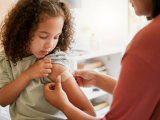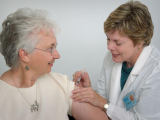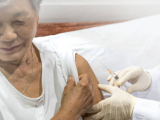Oct 30, 2009 (CIDRAP News) – An expert committee that advises the World Health Organization (WHO) today updated its guidance on pandemic H1N1 vaccines, recommending a single dose for most age-groups and advising that any of the forms are safe for pregnant women.
At a media briefing today, Dr Marie-Paule Kieny, director of the agency's Initiative for Vaccine Research, said this week's 3-day meeting of the Strategic Advisory Group of Experts (SAGE) on immunizations marked the group's first discussion of the pandemic H1N1 vaccine since mid July, when it took up the vaccine priority question and addressed concerns about low yields with the first vaccine seed strains.
"The level of evidence in October is much higher than July, and the recommendations are much more precise than July," she said.
After examining clinical trial data for all versions of the vaccine, the group recommended a single dose for everyone aged 10 and older, as long as such use in line with national regulatory authorities. Though the group said immunogenicity data are more limited for young children, it also recommended that countries that have children as a high-priority group administer one dose so that as many children can be vaccinated as possible.
The United States has prioritized children to receive the pandemic vaccine has recommended that those under age 10 receive two doses. Also, Europe's drug regulatory agency on Sep 23 announced it would stick to its initial recommendation that the three vaccines it approved be given in two doses, because data were insufficient to merit a one-dose recommendation. However, it added that one dose may be enough in adults.
At a separate press briefing today, reporters asked Thomas Frieden, MD, director of the US Centers for Disease Control and Prevention (CDC), about the difference between the SAGE recommendation and the CDC's guidance. He said preliminary vaccine data on children have not shown the desired immune response in children that would warrant a single-dose recommendation. Though the CDC is anticipating new data soon from the National Institutes of Health, "for the time being, we're sticking with what the ACIP [Advisory Committee on Immunization Practices] has recommended," Frieden said.
Kieny said the WHO group advised that more studies are needed to guide a recommended vaccine dose for immunocompromised patients.
Fourteen countries have now launched pandemic H1N1 vaccination programs, she said. In its review of early vaccine monitoring data for the pandemic, SAGE found no indication of unusual reactions, and it found that the events reported so far are well within the range of those seen with seasonal flu vaccines.
Given concerns about vaccinating pregnant women, the WHO panel looked at animal studies of all forms of the vaccine and found no evidence of direct or indirect harm to fertility, pregnancy, embryonic or fetal development, birthing, or postnatal development. Given the high risk of flu complications in pregnant women, the group said any licensed vaccine can be used in pregnant women, unless specific contraindications have been outlined by national regulatory bodies.
The United States is among countries where authorities have recommended that pregnant women not receive the intranasal, live attenuated H1N1 vaccine (LAIV). Public health officials were in a difficult position when the first pandemic vaccine doses were delivered, because nearly all of them were the LAIV version, though pregnant women are at the front of the line to be vaccinated. However, US officials have recently said the injectable version that pregnant women and other high-risk groups can receive makes up half of the increasing supply.
The group also took up the issue of whether seasonal and pandemic H1N1 vaccines can be given at the same time. In a statement today, the WHO panel said clinical trials on coadministration of the vaccines are ongoing, but it endorsed the CDC recommendation that the intranasal versions of the seasonal and pandemic vaccines should not be given together. The group said the seasonal and pandemic vaccines can be given at the same time provided both are inactivated (injectable) or one is inactivated and the other is LAIV.
Regarding options for the Southern Hemisphere's 2009-2010 seasonal flu vaccine, SAGE weighed whether a trivalent vaccine (pandemic H1N1 plus seasonal H3N2 and B) or a bivalent vaccine (seasonal H3N2 and B) plus a separate pandemic H1N1 vaccine would be best. They concluded that both formulation options should be available, depending on national needs.
See also:
Oct 30 WHO statement on SAGE recommendations
http://www.who.int/csr/disease/swineflu/notes/briefing_20091030/en/index.html




















